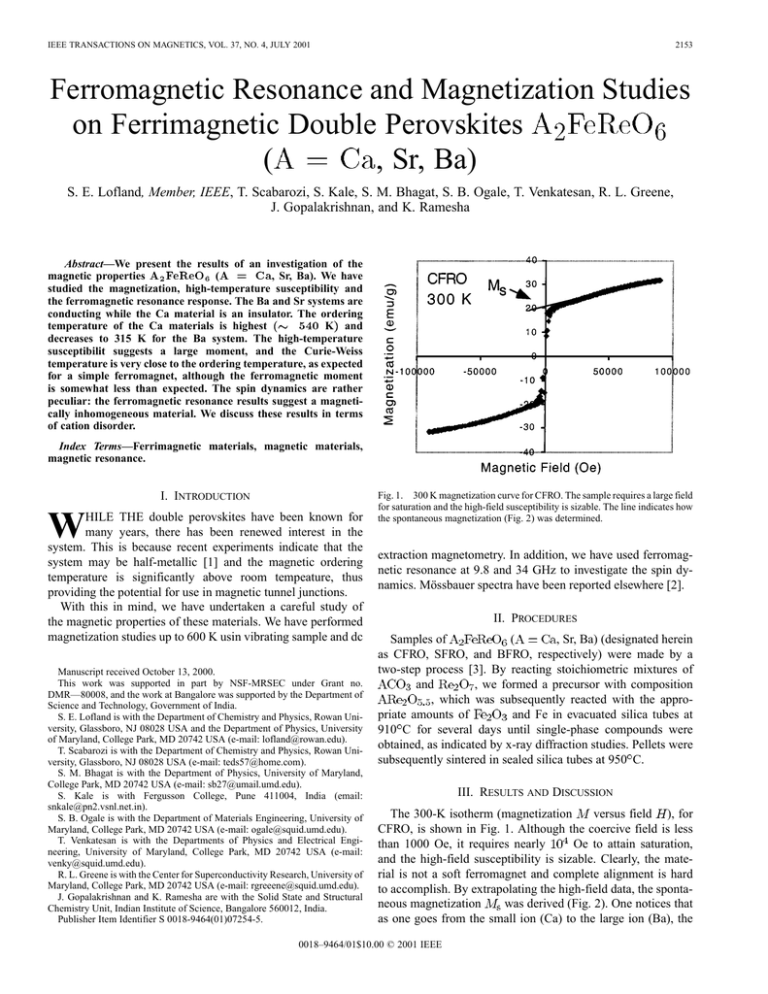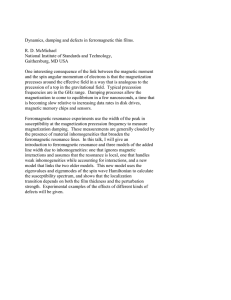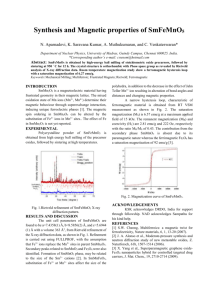Ferromagnetic Resonance and Magnetization Studies on Ferrimagnetic Double Perovskites ( A
advertisement

IEEE TRANSACTIONS ON MAGNETICS, VOL. 37, NO. 4, JULY 2001 2153 Ferromagnetic Resonance and Magnetization Studies on Ferrimagnetic Double Perovskites A2FeReO6 (A = Ca, Sr, Ba) S. E. Lofland, Member, IEEE, T. Scabarozi, S. Kale, S. M. Bhagat, S. B. Ogale, T. Venkatesan, R. L. Greene, J. Gopalakrishnan, and K. Ramesha Abstract—We present the results of an investigation of the magnetic properties A2 FeReO6 (A = Ca, Sr, Ba). We have studied the magnetization, high-temperature susceptibility and the ferromagnetic resonance response. The Ba and Sr systems are conducting while the Ca material is an insulator. The ordering temperature of the Ca materials is highest ( 540 K) and decreases to 315 K for the Ba system. The high-temperature susceptibilit suggests a large moment, and the Curie-Weiss temperature is very close to the ordering temperature, as expected for a simple ferromagnet, although the ferromagnetic moment is somewhat less than expected. The spin dynamics are rather peculiar: the ferromagnetic resonance results suggest a magnetically inhomogeneous material. We discuss these results in terms of cation disorder. Index Terms—Ferrimagnetic materials, magnetic materials, magnetic resonance. I. INTRODUCTION W HILE THE double perovskites have been known for many years, there has been renewed interest in the system. This is because recent experiments indicate that the system may be half-metallic [1] and the magnetic ordering temperature is significantly above room tempeature, thus providing the potential for use in magnetic tunnel junctions. With this in mind, we have undertaken a careful study of the magnetic properties of these materials. We have performed magnetization studies up to 600 K usin vibrating sample and dc Manuscript received October 13, 2000. This work was supported in part by NSF-MRSEC under Grant no. DMR—80008, and the work at Bangalore was supported by the Department of Science and Technology, Government of India. S. E. Lofland is with the Department of Chemistry and Physics, Rowan University, Glassboro, NJ 08028 USA and the Department of Physics, University of Maryland, College Park, MD 20742 USA (e-mail: lofland@rowan.edu). T. Scabarozi is with the Department of Chemistry and Physics, Rowan University, Glassboro, NJ 08028 USA (e-mail: teds57@home.com). S. M. Bhagat is with the Department of Physics, University of Maryland, College Park, MD 20742 USA (e-mail: sb27@umail.umd.edu). S. Kale is with Fergusson College, Pune 411004, India (email: snkale@pn2.vsnl.net.in). S. B. Ogale is with the Department of Materials Engineering, University of Maryland, College Park, MD 20742 USA (e-mail: ogale@squid.umd.edu). T. Venkatesan is with the Departments of Physics and Electrical Engineering, University of Maryland, College Park, MD 20742 USA (e-mail: venky@squid.umd.edu). R. L. Greene is with the Center for Superconductivity Research, University of Maryland, College Park, MD 20742 USA (e-mail: rgreeene@squid.umd.edu). J. Gopalakrishnan and K. Ramesha are with the Solid State and Structural Chemistry Unit, Indian Institute of Science, Bangalore 560012, India. Publisher Item Identifier S 0018-9464(01)07254-5. Fig. 1. 300 K magnetization curve for CFRO. The sample requires a large field for saturation and the high-field susceptibility is sizable. The line indicates how the spontaneous magnetization (Fig. 2) was determined. extraction magnetometry. In addition, we have used ferromagnetic resonance at 9.8 and 34 GHz to investigate the spin dynamics. Mössbauer spectra have been reported elsewhere [2]. II. PROCEDURES Samples of ( , Sr, Ba) (designated herein as CFRO, SFRO, and BFRO, respectively) were made by a two-step process [3]. By reacting stoichiometric mixtures of and , we formed a precursor with composition , which was subsequently reacted with the approand Fe in evacuated silica tubes at priate amounts of 910 C for several days until single-phase compounds were obtained, as indicated by x-ray diffraction studies. Pellets were subsequently sintered in sealed silica tubes at 950 C. III. RESULTS AND DISCUSSION The 300-K isotherm (magnetization versus field ), for CFRO, is shown in Fig. 1. Although the coercive field is less Oe to attain saturation, than 1000 Oe, it requires nearly and the high-field susceptibility is sizable. Clearly, the material is not a soft ferromagnet and complete alignment is hard to accomplish. By extrapolating the high-field data, the spontawas derived (Fig. 2). One notices that neous magnetization as one goes from the small ion (Ca) to the large ion (Ba), the 0018–9464/01$10.00 © 2001 IEEE 2154 IEEE TRANSACTIONS ON MAGNETICS, VOL. 37, NO. 4, JULY 2001 Fig. 2. Temperature dependence of the spontaneous magnetization of CFRO, SFRO, and BFRO. ordering temperature decreases as does the resistivity (not shown). We estimate the ordering temperatures to be 315, 405 and 540 K for BFRO, SFRO and CFRO, respectively. Attempts and determine the critical expoto use Arrott plots to locate nents proved fruitless as the fits were less than satisfactory for any reasonable numbers. This is perhaps tied to the observation that saturation is difficult to obtain. We studied the – loop at 5 K. Again, the approach to sat, uration is very slow, even at 90 kOe. By plotting versus we extrapolate the saturation values to 3.3, 3.2 and site for CFRO, SFRO and BFRO, respectively. Mossbauer experiments [2] suggest that the valence of Fe is mostly in BFRO, a mixture of and in SFRO, and in CFRO. However, the moments found from magmostly netization are smaller and nearly identical to each other. Next, we studied the high-temperature susceptibility of is linear in , and BFRO and SFRO (Fig. 3). In this regime, the susceptibility follows the Curie-Weiss formula, with (1) where is the Weiss temperature, the number density, and the effective “moment” of the ions. One finds the values to be 3.0 and 3.5 for BFRO and SFRO, respectively. Again, the values are somewhat lower than the moments indicated by the Mossbauer results but are in agreement with the ferromagnetic moments found by the magnetiza. tion study for K while it is 410 K for SFRO. For the BFRO, These values are only slightly higher than the corresponding ’s and would be reasonable for a Heisenberg ferromagnet. From this point of view, the systems appear to be relatively conventional localized ferromagnets. However, the dynamics and the approach to saturation suggest a different picture. Fig. 3. Temperature dependence of the inverse susceptibility (in cgs units) above T for BFRO and SFRO. The slopes of the lines give p values of 3.0 and 3.5 for BFRO and SFRO, respectively. Fig. 4. Temperature dependence of the resonance field of SFRO at 9.8 GHz. The temperature dependence is rather peculiar and not indicative of a simple ferromagnet. The ferromagnetic resonance studies were performed on thin mm mm mm . The lines at room temperaslabs ture are very wide (several kOe) and rather distorted. They are clearly symptomatic of magnetic inhomogeneities. Combining the data for the field applied parallel and perpendicular to the sample at both 9.8 and 34 GHz, the resonance fields yield with of about a few hundred G. As seen in Fig. 4, the temperature dependence does not correspond to any known behavior for a ferromagnet. Although not fully settled, the most likely explanation is that the material is an intimate mixture of coexisting ferromagnetic and antiferromagnetic regions leading to severe magnetic frustration. The lack of saturation in the magnetization curves and the inability to use Arrott plots are probably also symptomatic of this frustration. Magnetic frustration in these materials is perhaps not surprising. It is well known that the ordering of Fe and Re sites is not complete and rarely surpasses 95%. Not only does this create local distortions in the crystal structure, thereby changing the bond angle but also gives rise to antiferromagnetic superexchange interactions between neighboring Fe atoms. This lack of LOFLAND et al.: FERROMAGNETIC RESONANCE AND MAGNETIZATION STUDIES long-range order has been investigated by Monte Carlo simulations [4], which indicate the tendency of the material to nucleate magnetic clusters. IV. CONCLUSIONS In conclusion, we have measured the magnetic properties of Fe–Re double perovskites. Some of the static measurements, at first glance, are suggestive of behavior expected for a simple ferromagnet. However, high-field data and resonance experiments indicate a magnetically very inhomogeneous system. This is perhaps a consequence of disorder in the Fe and Re sites which results in magnetic clustering and not true long-range order. Presumably, one will have to minimize this effect before one can use these materials in tunneling-based devices. 2155 REFERENCES [1] K.-I. Kobayashi, T. Kimura, Y. Tomioka, H. Sawada, K. Terakura, and Y. Tokura, “Intergrain tunneling magnetoresistance in polycrystals of ,” Phys. Rev. B, vol. 59, pp. ordered double perovskites 11 159–11 162, May 1999. [2] J. Gopalakrishnan, A. Chattopadhyay, S. B. Ogale, T. Venkatesan, R. L. Greene, A. J. Millis, K. Ramesha, B. Hannoyer, and G. Marest, “Metallic ( and nonmetallic double perovskites, a case study of a , Sr, Ba),” Phys. Rev. B, vol. 62, pp. 9538–9542, Oct. 2000. [3] W. Prellier, V. Smolyaninova, A. Biswas, C. Galley, R. L. Greene, K. Ramesha, and J. Gopalakrishnan, “Properties of the ferrimagnetic ( , and Ca),” J. Phys. C, vol. double perovskites 12, pp. 965–973, Feb. 2000. [4] A. S. Ogale, S. B. Ogale, R. Ramesh, and T. Venkatesan, “Octahedral : Monte cation site disorder effects in double perovskite Carlo simulation study,” Appl. Phys. Lett., vol. 75, pp. 537–539, July 1999. Sr FeReO A FeReO A = Ca A FeReO A = Ba Sr FeMoO






